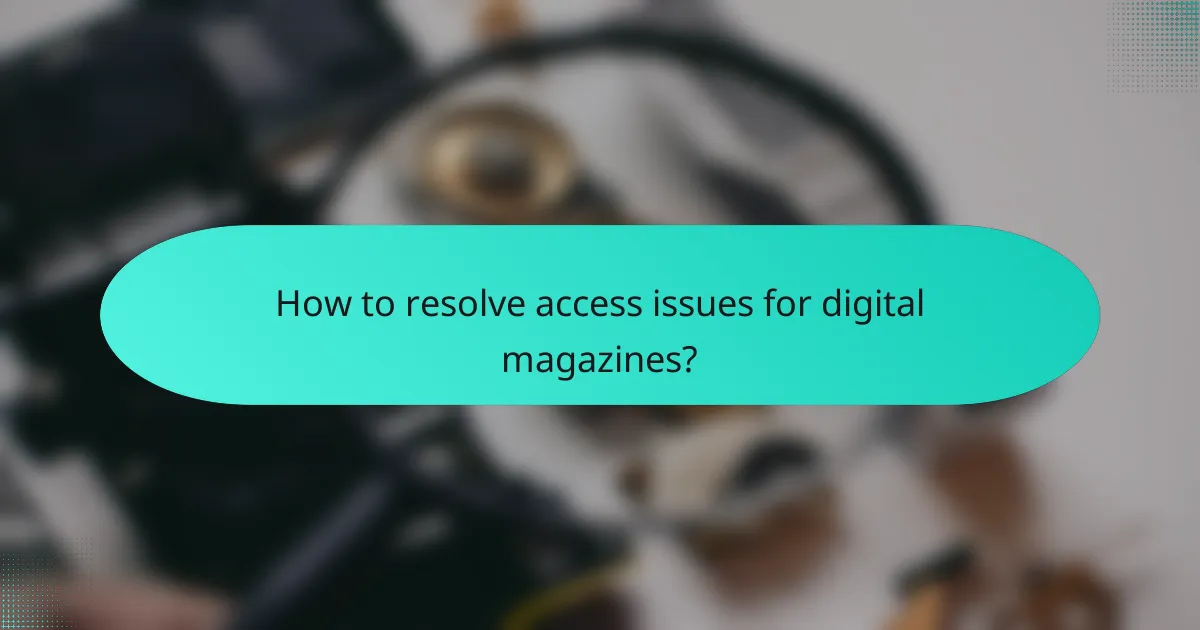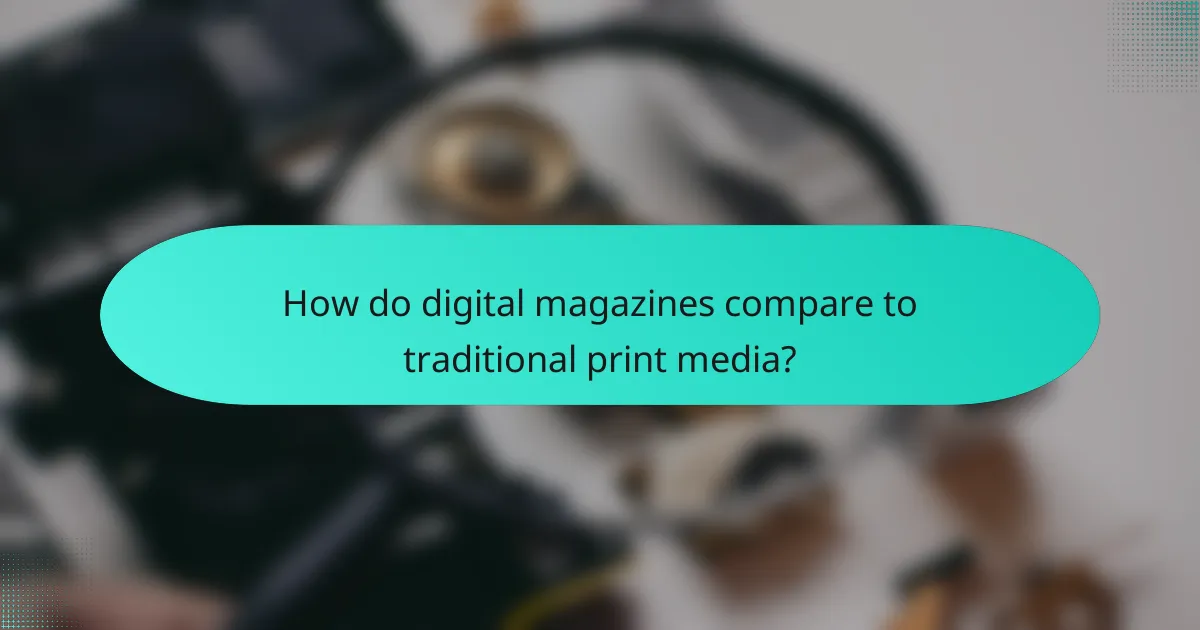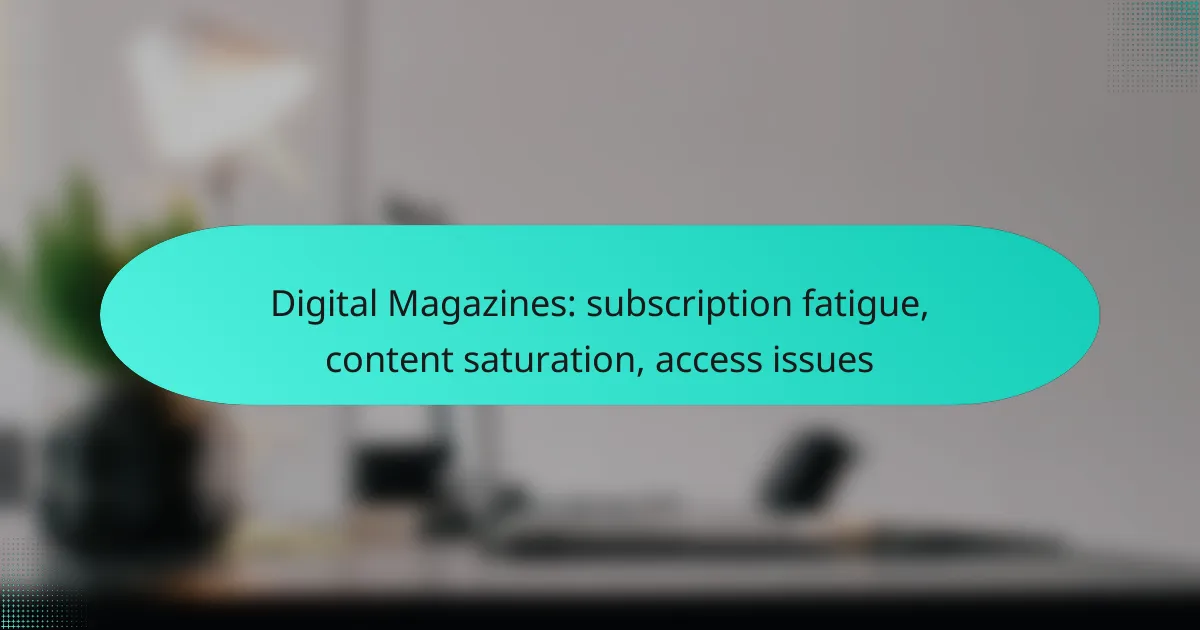In the rapidly evolving landscape of digital magazines, readers often face subscription fatigue, content saturation, and access issues. Publishers can mitigate these challenges by offering flexible subscription models, curating high-quality content, and ensuring seamless access across devices. By prioritizing personalized experiences and enhancing user engagement, digital magazines can better meet the diverse needs of their audience.

How to combat subscription fatigue in digital magazines?
To combat subscription fatigue in digital magazines, publishers should focus on offering flexible options and personalized experiences that cater to individual preferences. By addressing the diverse needs of readers, magazines can enhance engagement and reduce churn rates.
Flexible subscription models
Flexible subscription models allow readers to choose plans that fit their consumption habits. Options such as monthly, quarterly, or annual subscriptions can accommodate varying preferences and budgets, making it easier for users to commit.
Consider offering tiered pricing, where basic access is available at a lower cost, while premium content is available for a higher fee. This approach can attract a broader audience while providing opportunities for upselling.
Bundled content offerings
Bundled content offerings combine multiple magazines or digital resources into a single subscription package, providing greater value to readers. This strategy can reduce the perceived cost per title, making subscriptions more appealing.
For example, a subscription could include access to several niche magazines within a specific genre, allowing readers to explore various topics without needing multiple subscriptions. This can enhance user satisfaction and retention.
Personalized content recommendations
Personalized content recommendations leverage user data to suggest articles and magazines tailored to individual interests. By analyzing reading habits and preferences, publishers can create a more engaging experience that keeps readers coming back.
Implementing algorithms that curate content based on previous interactions can significantly improve user engagement. Consider offering a “recommended for you” section that highlights articles aligned with the reader’s interests.
Trial periods for new subscribers
Trial periods for new subscribers provide an opportunity to experience the magazine without financial commitment. Offering a free or discounted trial can encourage potential subscribers to explore content and assess its value.
Typically, a trial period of one month is effective for allowing users to engage with various articles and features. Ensure that the transition to a paid subscription is seamless and clearly communicated to avoid confusion at the end of the trial.

What strategies address content saturation?
To combat content saturation, digital magazines can implement strategies that enhance user experience and prioritize meaningful engagement. These approaches focus on curating relevant content, emphasizing quality, and utilizing formats that foster interaction.
Curated content experiences
Curated content experiences involve selecting and presenting information that aligns closely with audience interests. By filtering out less relevant material, magazines can create a more appealing and personalized reading experience.
For instance, a magazine might offer themed issues or highlight trending topics based on reader preferences, ensuring that subscribers receive content that resonates with them. This can lead to higher satisfaction and retention rates.
Quality over quantity focus
Focusing on quality over quantity means prioritizing well-researched, insightful articles instead of churning out numerous pieces. This strategy encourages deeper engagement and builds trust with the audience.
Magazines should aim for a balanced output, perhaps releasing fewer articles each month but ensuring that each one is thoroughly vetted and provides substantial value. This can help mitigate feelings of overwhelm among readers.
Engagement-driven content formats
Engagement-driven content formats, such as interactive articles, videos, and podcasts, can significantly enhance reader involvement. These formats invite users to participate actively rather than passively consuming information.
For example, incorporating polls, quizzes, or comment sections can encourage readers to share their opinions and experiences, fostering a community around the magazine. This not only increases engagement but also helps in gathering valuable feedback for future content planning.

How to resolve access issues for digital magazines?
To resolve access issues for digital magazines, users should explore various solutions that enhance compatibility and usability across devices. This includes leveraging cross-platform accessibility, offline reading options, and understanding subscription sharing policies.
Cross-platform accessibility solutions
Cross-platform accessibility solutions ensure that digital magazines can be accessed on different devices, such as smartphones, tablets, and computers. Look for platforms that offer apps or web access compatible with both iOS and Android systems.
Consider using services that allow syncing across devices, so you can start reading on one device and continue on another without losing your place. Popular digital magazine platforms often provide this feature, enhancing user experience.
Offline reading options
Offline reading options allow users to download digital magazines for later access without needing an internet connection. This is particularly useful for commuters or travelers who may not always have reliable internet access.
Check if your chosen magazine platform supports offline downloads. Many apps let you save issues for a limited time, so ensure you download them while connected to Wi-Fi to avoid data charges.
Subscription sharing policies
Subscription sharing policies vary by publisher and can significantly impact access to digital magazines. Some platforms allow sharing subscriptions with family members or friends, while others may restrict access to a single user.
Review the terms of service for your digital magazine subscriptions to understand how sharing works. If sharing is permitted, it can help reduce individual costs and improve access for multiple users within a household.

What are the key factors influencing digital magazine subscriptions?
The key factors influencing digital magazine subscriptions include content relevance and quality, user experience and interface, and pricing competitiveness. These elements significantly impact a subscriber’s decision to engage with and maintain their subscriptions.
Content relevance and quality
Content relevance and quality are crucial for attracting and retaining subscribers. Magazines that consistently provide high-quality, engaging, and pertinent content are more likely to keep their audience interested. For instance, niche publications that cater to specific interests often outperform generalist magazines in subscriber retention.
To assess content quality, consider factors such as editorial standards, the expertise of contributors, and the uniqueness of the topics covered. Regularly updating content and aligning it with current trends can enhance its relevance and appeal.
User experience and interface
A seamless user experience and intuitive interface are vital for digital magazine subscriptions. Readers expect easy navigation, quick loading times, and a visually appealing layout. Magazines that invest in user-friendly designs often see higher engagement rates.
To improve user experience, prioritize mobile optimization, as many users access content on smartphones and tablets. Conducting usability tests and gathering feedback can help identify areas for improvement, ensuring that the interface meets subscriber needs.
Pricing competitiveness
Pricing competitiveness plays a significant role in attracting new subscribers and retaining existing ones. Digital magazines must balance affordability with perceived value. Offering tiered subscription plans or promotional discounts can make subscriptions more appealing.
Consider analyzing competitor pricing to ensure your magazine remains attractive in the market. Additionally, providing exclusive content or member benefits can justify higher price points and enhance subscriber loyalty.

How do digital magazines compare to traditional print media?
Digital magazines offer unique advantages over traditional print media, including lower costs and enhanced accessibility. However, they also face challenges such as subscription fatigue and content saturation, which can affect user engagement.
Cost-effectiveness of digital formats
Digital magazines typically have lower production and distribution costs compared to print magazines. This often translates to more affordable subscription prices, which can range from a few dollars to around twenty dollars per month, depending on the publication.
Additionally, digital formats eliminate expenses related to printing and shipping, allowing publishers to allocate resources toward content quality and user experience. Readers can benefit from promotional offers or bundled subscriptions that further reduce costs.
Environmental impact considerations
Digital magazines significantly reduce paper usage, contributing to lower deforestation rates and waste generation. While the energy consumption of devices used to read digital content is a factor, the overall environmental footprint of digital magazines is generally smaller than that of print media.
Many publishers are also adopting sustainable practices, such as using renewable energy sources for their servers. Readers concerned about their environmental impact can choose digital options to support eco-friendly initiatives.
Accessibility and convenience advantages
Digital magazines provide instant access to a vast array of content from anywhere with an internet connection. This convenience allows readers to explore diverse topics and publications without the need for physical storage space.
Moreover, digital formats often include features like adjustable text size, search functions, and multimedia elements, enhancing the reading experience for users with varying preferences and needs. Subscribing to digital magazines can also enable readers to stay updated with the latest issues automatically, ensuring they never miss out on new content.

What emerging trends are shaping the future of digital magazines?
Emerging trends in digital magazines include the integration of augmented reality features and AI-driven content personalization. These innovations aim to enhance user engagement and tailor content to individual preferences, addressing challenges like subscription fatigue and content saturation.
Integration of augmented reality features
Augmented reality (AR) features are increasingly being incorporated into digital magazines to create immersive experiences. Readers can interact with content by using their devices to view 3D models, animations, or additional information overlaid on the printed page or screen.
This technology not only captivates readers but also provides a unique way to present advertisements and product placements. For example, a fashion magazine might allow users to visualize clothing items in their own environment through AR, enhancing the shopping experience.
AI-driven content personalization
AI-driven content personalization is transforming how digital magazines deliver articles and features to readers. By analyzing user behavior and preferences, AI can curate content that aligns with individual interests, making the reading experience more relevant and engaging.
Magazines can utilize algorithms to recommend articles based on past reading habits, ensuring that subscribers receive content that resonates with them. This approach not only increases reader satisfaction but also helps publishers combat content saturation by focusing on quality over quantity.
